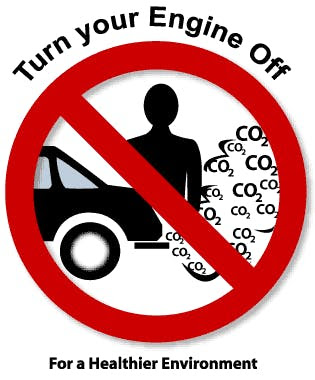Canadians idle their engines an average of eight minutes a day. This unnecessary idling contributes to both climate change and poor air quality. To gauge the possibility of reducing engine idling, we conducted a pilot study in two locations in which idling is common: schools and Toronto Transit Commission “Kiss and Ride” parking lots.
Idling frequently occurs when parents and guardians wait to pick a child up at the end of the school day. Idling is also common at Toronto’s aptly named “Kiss and Ride” parking lots when partners wait at the end of the workday for a partner to return on a train from downtown Toronto. Baseline observations indicated that motorists in these two locations were idling their engines 53% of the time.
Two strategies to reduce engine idling were pilot tested. In the first strategy, we placed a minimum of four signs in various locations at the schools and Kiss and Ride parking lots. Why? Our barrier and benefit research revealed that the number one reason why Canadians idle is that they forget to turn off their engines. The signs were attached to concrete bases and were lower than most signs to increase the probability that they would be seen. By themselves, the signs did not affect engine idling.
Concurrent with the first strategy, we tested a second strategy in which we used the signs in conjunction with personal contact, prompts, and commitments. We used the following script for these conversations:
“Good afternoon/ evening. My name is _______________ , and I am working with the City of Toronto on a project aimed at reducing vehicle engine idling. We want to decrease the harmful emissions that occur when vehicle engines are left running. These emissions, as you may know, decrease air quality and contribute to climate change. We are asking motorists to commit to turning off their engines when they are parked and waiting in their vehicles. Would you be willing to join the growing number of people who have made a similar pledge and agree to turn off your vehicle’s engine when you are parked and waiting in your vehicle? We are asking those who pledge to turn off their vehicle engine to place this sticker on their window. This sticker will both serve as a reminder to turn your engine off and as a display of your commitment to reducing engine idling. We designed the sticker so that you can easily remove it from your window at a later time. Would you be willing to attach this sticker to your window? We are also giving out these information cards which explain how turning off your engine can save you money, help you breathe easier, and spare the air. Would you like to have one?”
While the signs by themselves did not reduce engine idling, the frequency of engine idling was reduced by 32% and idling duration by 73% when combined with personal contact and commitments. These remarkable reductions occurred even though each conversation lasted only about a minute per motorist. The effectiveness of this pilot led Natural Resources Canada to create an anti-idling toolkit that municipalities across Canada could utilize. This toolkit included all the resources that a community or organization would need to launch its own anti-idling program. As a consequence of developing this toolkit and making it freely available on the web, over 200 Canadian communities have now delivered their own anti-idling programs.
Perhaps the most critical lesson from Natural Resources Canada’s anti-idling program is the feasibility of following up a successful pilot with the development of toolkits that others can utilize. Given that similar barriers and benefits exist in other locations (a testable assumption), the development and dissemination of these toolkits could lead to the rapid deployment of successful programs in numerous communities.
I’m currently planning fall community-based social marketing virtual workshops. To learn more sign up here.
